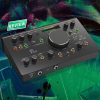
Top 5: Ed Stasium
Through playing in garage bands, American engineer/producer Ed Stasium’s passion for recording began young. By the 1970s he was developing his trade with roles in studios before shifting to an independent studio career. Stasium has worked with a range of artists, including Ramones, Talking Heads, Mick Jagger, Living Colour, Motorhead, and Hoodoo Gurus. Here are his Top 5 essential studio tools.
By Joe Matera
15 December 2022
DANGEROUS 2-BUS LT
I mix everything in the box with Pro Tools these days, but when I first adopted the format I was bouncing directly to disc. During a conversation with my mastering engineer pal Greg Calbi, he suggested that I try a process of using the analogue outputs of Pro Tools. Greg then put me in touch with Dangerous Music founder Chris Muth who set me up with one of his 2-Bus LT summing mixers. Running analogue from Pro Tools into the 2-Bus, and then recording back into Pro Tools through inputs 1 and 2 has made such a big difference, and is how I do all my mixing now.


STEVEN SLATE DRUM TRIGGER 2
I do quite a bit of mixing for indie artists, and as their recordings are often done in a makeshift studio in someone’s house — in a bedroom or basement — they don’t always capture drums well. I love the Slate Trigger for its simplicity here. It mimics how things were done when I was mixing analogue on an SSL back in the day — where I would duplicate the snare and kick drums and bring them up on an adjacent faders. I would take these second ‘processed’ channels and add gate, compression, and EQ to them, and then sneak them up behind the original tracks. The Slate Trigger takes the place of all of that. It’s really responsive, has great dynamics, and there’s also a great variety of samples that they’ve put together. I really love this piece of gear.
HEAR TECHNOLOGIES HEARBACK HUB & MIXERS
Since moving to San Diego about eight years ago the majority of my work was done at home, and for years there I didn’t have a multi-channel headphone system. Not having a separate cue network for artists to hear and control their own monitor mixes was proving difficult, but my friends at Vintage King recommended Hear Tech’s easy-to-use Hearback system. As my home studio isn’t set up like a major studio — with the ‘control room’ being in a spare bedroom — running something like this is essential. The system is fantastic. It sounds great, and has a compressor so you can add a little bit to prevent the artist from blowing out their headphones. This is especially useful for drummers and aggressive vocalists who like to crank it!


MANLEY FORCE PREAMP
I have done the majority of recordings at home where I don’t have access to a large format desk, so the Manley gear serves me very well here. The Force is a four channel tube preamp and I use it all the time. I love it on drum overheads, and on electric and acoustic guitars.

TRIDENT FLEXIMIX CHANNEL STRIPS
I love Trident as I used to work at Le Studio Morin-Heights where they had the first of the original thirteen A-Range consoles in North America. I have a set of four Trident Fleximix modules that I purchased from eBay and am told that they came out of Queen’s first touring desk. I’ve had these modules for fifteen years now and they sound fantastic. They have a unique clarity that sees them used on hi-hat, tom toms, ride cymbal and acoustic guitar. In fact, they are permanently routed from those drum mics. They’re crystal clear, and have 3-band EQ with a parametric mid-range, and they’re nicely made so they don’t break down.



























RESPONSES